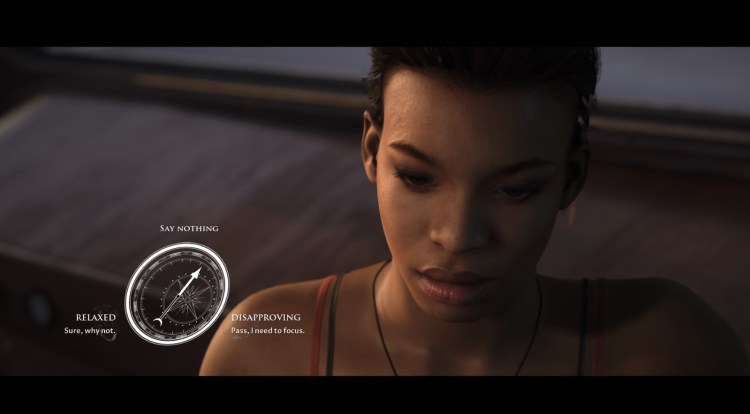The developers of Until Dawn — my favorite game of 2015 — have come up with an innovative multiplayer mode with their latest horror game, Man of Medan, the first installment in a five-story anthology dubbed The Dark Pictures.
I attended a preview session aboard the USS Hornet, a spooky old ship that matches the ambiance of the derelict ship in Man of Medan. These games are created in a cinematic art style, with amazingly realistic, motion-captured human faces and bodies. It’s almost like being inside a supernatural horror movie, where you can play the characters in the film. But in contrast to a film, you get to make choices that determine the sequence of events and the ultimate fate of the characters.
I played the first part of the game in two-player Shared Story mode with another journalist colleague who was also playing it for the first time. And then we jumped to the middle of the game and recorded the scenes that you can see in the video. I also played the same scene in Movie Night mode, where up to five players can play one character and pass the controller around as other characters become active.
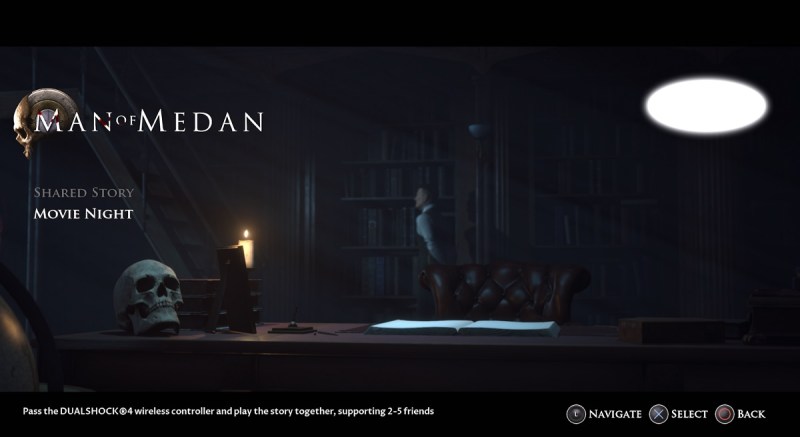
Above: In movie night mode, 5 players can play Man of Medan in offline mode.
Afterward, I interviewed Pete Samuels, managing director of Supermassive Games and executive producer of The Dark Pictures anthology, and James Scalpello, head of marketing. Samuels told me that the branching possibilities of Man of Medan — with five characters that I saw as playable — are a lot more plentiful than Until Dawn, which had eight playable characters.
June 5th: The AI Audit in NYC
Join us next week in NYC to engage with top executive leaders, delving into strategies for auditing AI models to ensure fairness, optimal performance, and ethical compliance across diverse organizations. Secure your attendance for this exclusive invite-only event.
In this game, all playable characters can live or die. In fact, there are 69 scenarios where characters can die in Man of Medan. Five friends set sail on a holiday diving trip in search of a rumored World War II wreck. Based on a myth about a ghost ship, the story forces you to make choices that can mean life or death for your character.
Bandai Namco is publishing the game on the Sony PlayStation 4, Xbox One, and PC on August 30. Here’s an edited transcript of our interview. Beware of spoilers in our interview. You can also check out some soundless gameplay in the video.
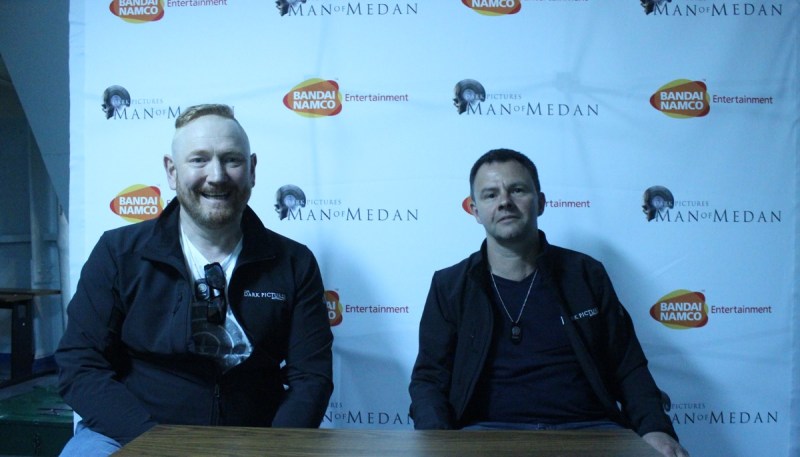
Above: Pete Samuels (left), CEO of Supermassive, and James Scapello, head of marketing.
GamesBeat: So it all turned out well. Nobody died or anything. It sounds like the worst outcome would be [spoiler deleted] getting shot as he leaves the boat?
Pete Samuels: Yeah, that’s one of the worst outcomes. There’s another one that’s equally bad, but we don’t want to talk about spoilers quite yet. You can actually do something in there that turns out very badly [laughs].
GamesBeat: But you don’t see too many consequences this early in the game?
Samuels: That’s true. The consequences usually — the big consequences often come later. There are still some in this game. You can get shot twice. You can get shot in the leg. Someone else can get shot. You can end up in a pretty bad way.
GamesBeat: There were two pictures that I remember. One showed Julia kind of sick, and the other one showed Brad in the bathroom, I think? Or in one of the rooms. I didn’t see much significance to either of those. Are you just showing us that you’ll see something in the future and you’re learning about it?
Samuels: One of those premonitions just doesn’t happen until, potentially, much later on. You’re not getting the full context within that scene, because you haven’t played all the way through.
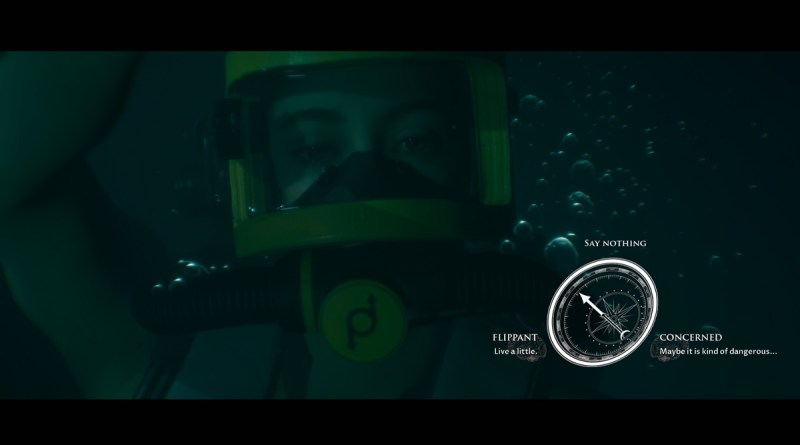
Above: Decisions, decisions.
GamesBeat: The Julia one doesn’t happen in this sequence, then?
Samuels: No. Nor does the Brad one. They both happen later. But they are both potentially significant. The reason they’re there is that when people played Until Dawn, people would look at the premonitions there and figure out how to avoid them if they looked bad. For example, Julia gets sick. “What action could I have taken that leads to Julia getting sick?” That’s on their mind when they’re making decisions.
GamesBeat: Maybe it was the decompression problem?
Samuels: Maybe it is? [laughs]
GamesBeat: There are fewer characters you control at any given time, compared to Until Dawn. But the possibilities are much greater, I take it?
Samuels: Yeah, much greater. There’s much more content. We’ve said that all five characters can live or die, but there are 69 deaths. To see all of them you’d have to play through at least eight or nine times. There’s much more branching content. And of course we’ll give people more ways to play it, with the couch co-op mode and the movie night and the shared story mode, the two-player mode. That’s something we were keen to do, to give people more reasons to play.
James Scalpello: The couch co-op is giving you a nice way to facilitate the way people played Until Dawn, giving them something else to try. You can select a character, play all five characters, and pass the pad around. There are lots of different opportunities for players.
GamesBeat: If you play it that way, then do you get a much longer experience than if you’re just playing one character, single-player?
Samuels: No, because you’re not controlling only one character in single-player.
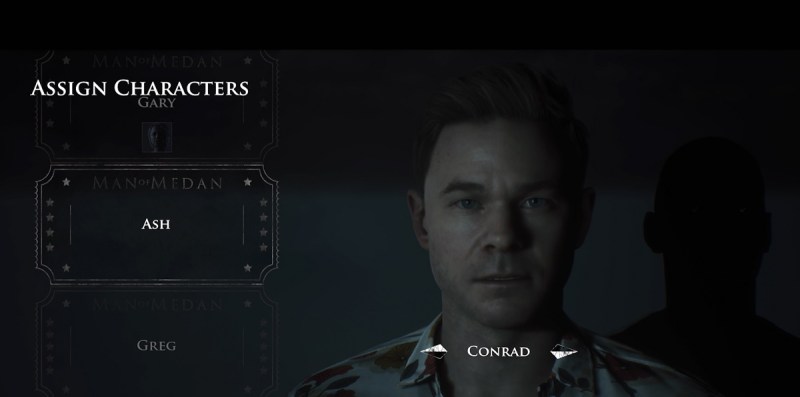
Above: You can assign a player to a character in Movie Night mode.
GamesBeat: So you don’t see all five characters taking a turn?
Samuels: If you play movie night with five people, then the way it sets up is that you assign characters to people. When it’s that character’s turn to be controlled, the pad goes to the player that has that character. I can imagine people playing that too.
GamesBeat: But you’re not going back in time to have the other — there’s the underwater part below, and then the surface part–
Samuels: Yeah, we do shift times. You play part of both of them. But it’s still a continuous story.
GamesBeat: You’re not rewinding a clock.
Samuels: No, no.
GamesBeat: What was more difficult about making all of these choices available to everyone?
Samuels: Without a doubt, the online co-op threw up some challenges in development, for a whole bunch of reasons. How to keep both players’ stories going at the right pace? Because pace is really important in delivering a narrative. How to make both stories interesting all the time, so that both have great content all the way through?
It’s like the challenges we always have when we’re making a single-player stories. It’s just that those challenges doubled or tripled. But we have a great team and good designers that have some great experience with designing for narrative. All that experience I think has given us a great result.
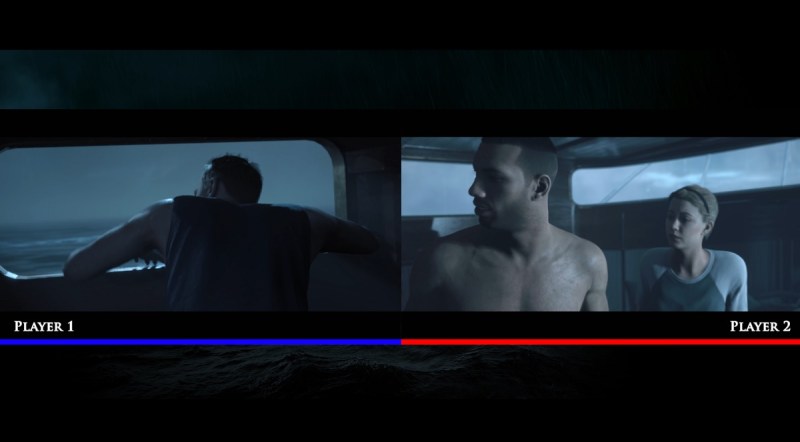
Above: What each player sees in the same scene in Man of Medan two-player multiplayer.
GamesBeat: In the beginning tutorial it looks like you wind up dying no matter what. I randomly chose to hide and then I got shot.
Samuels: Yeah, you’ll find that in our prologues. Generally in our prologues people die and you can’t avoid it. They’re there for tutorial. They’re there for backstory. Then we start with a fresh cast of characters. It’s another thing about horror, and it’s part of the way that we do it, our style. We prepare you for seeing plenty of death by showing you some people getting killed really early in the story. [laughs]
GamesBeat: The quick time events, are they any faster or slower than they used to be? I felt like they were faster.
Samuels: [laughs] Yeah, I thought they were a little faster, too.
GamesBeat: But the second time around I could get them right. Just not the first time, mostly.
Samuels: They vary, depending on where they are in the game and how you’ve gotten to that path and how likely it would be for you to escape that situation, having gotten yourself into it. That affects how much time we put on things like the QTEs.
GamesBeat: Was the aiming element fairly new, then, like in the boxing scene in the beginning? I don’t remember that from your earlier games.
Samuels: It’s something we’ve done before. We’ve just looked to improve it, like everything in the game we’ve done before. A little better, a little smoother. The heartbeat thing, that’s new, having to keep calm. And again, not with any desire to make it difficult to play. That’s not its purpose. Its purpose is to carry on for quite some time and put that stress on you as a player. If you make one mistake, you could kill someone.
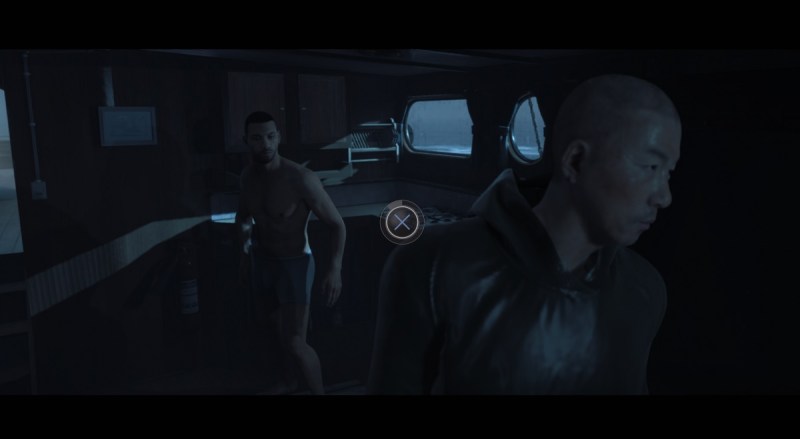
Above: Be ready for the fast QuickTime events in Man of Medan.
GamesBeat: Do we not know who the Man of Medan is yet? Or did I miss that?
Scalpello: All the stories in the Dark Pictures have an element of the real world in them – fact, fiction, legend, whatever you like. All of them have that. You can go out and google the Man of Medan and you’ll find that story [SS Ourang Medan]. There’s a story out there of a postwar ship commandeered by the U.S. that gets into a storm and something happens and they all die in mysterious circumstances, and then that ship’s left floating around the South Pacific forever.
Samuels: The name of the ship that it’s based on is the Ourang Medan, which is a quite famous myth or conspiracy theory. In Until Dawn it was the Wendigo myth that we researched. In this it’s the myth around the Ourang Medan. For our second, third, fourth, fifth, sixth, seventh, eighth in the series, there’s always a hook into reality or conspiracy theory or long-standing myth.
Scalpello: It gives a nice added element for players. They can learn about that story. There are fifty different secrets in the game that you can go out and find and discover that story. But you can also go and google and find out more about the real-world part of it as well.
GamesBeat: The curator, is he going to be in all of the games?
Samuels: He is, yeah. He has his own story going on across the series.
Scalpello: He’s the one constant across all of them. Obviously the characters and scenes and stories are all separate between the Dark Pictures, but he’s the one constant that sits across them.
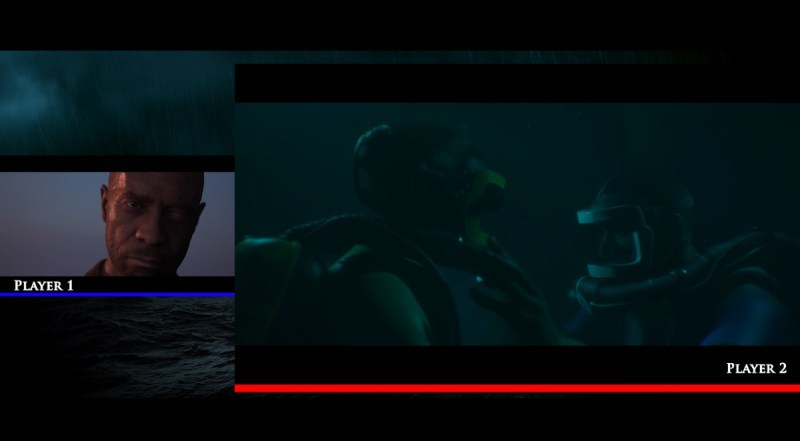
Above: Two players play different characters simultaneously in the same story in Man of Medan multiplayer.
GamesBeat: There’s a thread that goes through all of the games, then? It’s not just a bunch of short stories.
Samuels: There is a thread. There’s a thread that doesn’t affect the stories that goes across them.
Scalpello: There are little Easter eggs as well that we’ve put in, that you may not necessarily notice until you get to game two or three and you think, “Aha, I saw that in the first one.” We have these tiny little threads going across them.
GamesBeat: I saw the shrouded guy on the book as well. That felt like a foreshadowing of those guys in the shrouds coming on board.
Samuels: Oh, right, right. We try to do a good amount of foreshadowing, and not just within the same story, but across the different stories as well.
GamesBeat: If this one serves a purpose, and some of the other stories coming after this are different, what is this one’s purpose?
Samuels: A good question. It’s to start the series off well. It’s to start to learn about what people want and what people want more of as we develop the rest of the series. The second one’s already in production.
Scalpello: We had a lot of messages to get across with this first one, because obviously we’re announcing the Dark Pictures, this brand of shorter horror stories that we’re going to tell. We have multiplayer. It’s multi-format. And obviously we have a new story. This first instance, I think, has been a bit more complicated for us to tell, but once people understand what Dark Pictures is, it’ll be much easier for us to announce and launch subsequent games.
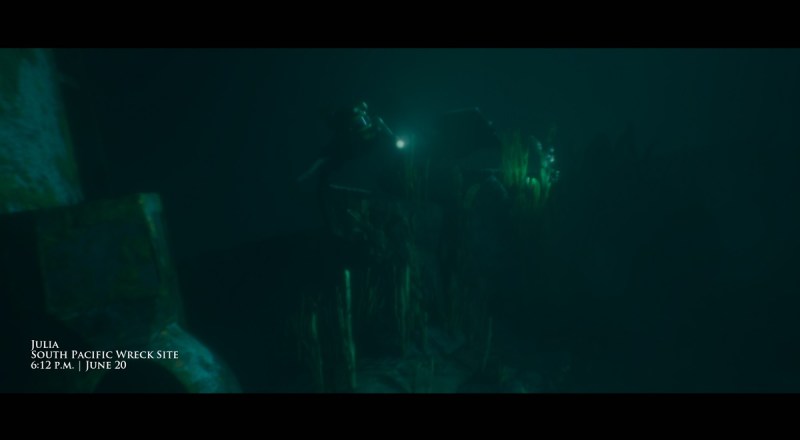
Above: A spooky find in Man of Medan.
GamesBeat: Are you not using Sony’s PlayLink, with the phones?
Samuels: No. The big, important thing for us is that it’s multiplatform and supports the same features across multiple platforms. That’s where our focus has been.
GamesBeat: It’s still designed to be one person’s choice with each decision, as opposed to voting happening.
Scalpello: Yes, exactly. Obviously the story is your choice, and it’s definitely your story, but it’s the not quite the same in shared story. You have two humans making that choice, which really changes things, changes that dynamic. You never quite know what the other person’s done, and the implications of that can happen quickly or quite far ahead along the line. It really does change the story. But yes, it’s always your choice, whether it’s one or two or five players in movie night.
